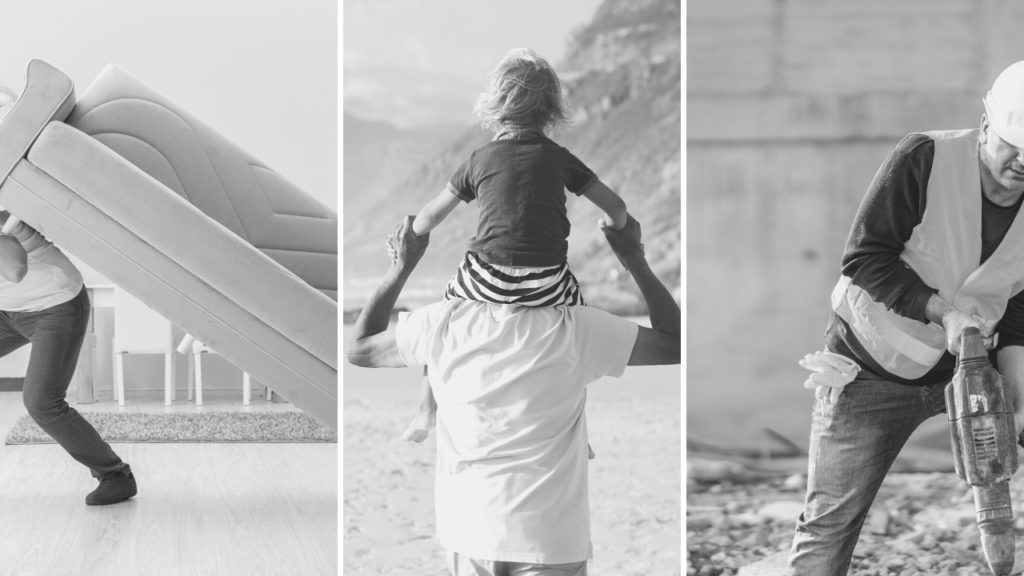
Sophie Pacek
Exercise Physiologist, Healthy Connections
My partner and I have recently moved house. It’s only when you’re in that circumstance that you realise how much you own! Anyway, it took a full day and a few hands to move all of our furniture and belongings from one place to another. We were lifting heavy boxes, couches, a fridge, beds and bulky items. Whilst thankfully none of us were too sore the day after, it got me thinking about the importance of correct posture and technique under load to keep the spine safe.
Manual handling
Many of you would have come across the term ‘manual handling’, particularly in a workplace setting. However, it also applies to home and leisure settings. It refers to any activity that involves an individual exerting a force to lift, lower, push, pull, carry or otherwise hold, or restrain a person, animal or object (Safe Work Australia, 2016).
Examples of activities include:
- Repetitive actions e.g. lifting several boxes, vacuuming / mopping
- Sustained postures e.g. standing over a workbench
- Exposure to vibration e.g. using a chainsaw, hedger or jackhammer
- Moving people e.g. assisting an older person out of a chair, carrying a child
- Moving furniture
- Extended reaching e.g. up to high cupboards, gutter maintenance and changing light bulbs
- Stooping to low surfaces e.g. vacuuming underneath the bed

These activities may become hazardous if there is exposure to sustained or repetitive force greater than the body can handle (Safe Work Australia, 2016). This varies between individuals but the main consequence of hazardous manual tasks is injury, with low back pain being the most reported type of injury.
An anatomy lesson on the spine
The spine is made up of 33 vertebrae in 5 sections (see image for details). The vertebrae are the bones that surround and protect our spinal cord and they are connected by cushiony surfaces called intervertebral discs. These discs are designed to absorb shock and force placed on the spine during movement (Ehrman et al., 2013).

As the spinal cord runs from our brain to our pelvis, little nerve roots sprout out each side of the spine through holes made by two interconnected vertebrae. These roots branch out to all parts of the body to facilitate sensation and movement (Ehrman et al., 2013). Surrounding the vertebrae and nerves are muscles which aid with movement so that we can bend over, straighten, twist and bend to the side. Injury to the lower back can involve one or all of these structures. There are many reasons why low back pain can occur, but today we are going to focus on mechanical back pain.
The jam doughnut analogy
Let’s use an analogy to explain back pathologies caused by mechanical (movement) dysfunction. Imagine the intervertebral discs (those squishy, cushiony things in between each vertebrae) are jam-filled doughnuts. When we bend forward, pressure is applied onto the front part of each vertebrae as well as each disc. This is usually quite safe when we go about our day; however, if we are in this posture under load, the extra force increases the risk of compressing a disc on one side and causing it to burst and leak jam out. This can manifest as a disc bulge (where part of the doughnut bulges into the space where spinal nerves run but does not break open) or in more severe cases, a disc herniation (fully blown jam leakage).
When a bulge or herniation occur, it can push up or rub against the nerve roots, causing pain, numbness and tingling. This in turn can cause muscles to tighten as a protective mechanism for affected areas, which unfortunately often manifests as more pain. The result is pain that can range from acute (lasting a few days) or chronic (lasting a few weeks or months), localised or referred, neural and/or muscular, and affect several structures.

This video provides a great summary of the different types of low back pain (first 5 minutes) but feel free to watch the whole clip for information on how to manage the pain.
In conclusion, we often expose our low back to great loads and forces which, if performed in a non-optimal posture or technique, can result in injury. Please tune in to our next blog about HOW to perform common movements under load safely for our spines.
Stay safe, wash your hands and keep moving!
Sophie
References
- Ehrman, J. K., Gordon, P. M., Visich, P. S., & Keteyian, S. J. (2013). Clinical Exercise Physiology. Human Kinetics: Champaign, IL.
- Safe Work Australia. (2016). Hazardous Manual Tasks – Code of Practice. Retrieved from https://www.safeworkaustralia.gov.au/system/files/documents/1705/mcop-hazardous-manual-tasks-v2.pdf



